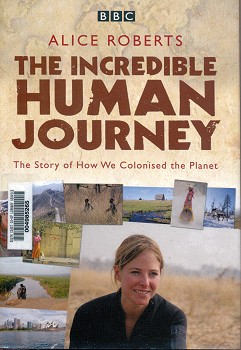 |
surfresearch.com.au
roberts : human journey, 2009 |
| home | catalogue | history | references | appendix |
|
For an earlier associated
entry , see:
2005 Debora
Smith (Science Editor) :
Earth's first beachcombers ended up in Australia.
Sydney Morning
Herald : Weekend Edition, May 14-15 2005
News : Page 13.
Reporting research
developments published in Science, 13 May 2005.
Page 72
There is no evidence
for boats from this long ago (125,000 years ago), but it seems reasonable
to me to assume that modern humans living on the coast would have had the
ingenuity to invent them.
Small watercraft
would have meant that people could have crossed the mouths of rivers and
better exploited coastal resources.
If they could
see Arabia across the water, and if their families were struggling to survive
on the African coast, as Oppenheimer suggests, that voyage seems like a
very sensible option.
In fact, there
might even have been a maritime community all around the shores of the
Red Sea, providing a base from which to spread along the southern coast
of Arabia.
Chapter 2: Footprints
of the Ancestors
A Stone Age
Voyage: Lombok to Sumbawa, Indonesia.
Page 118
It is quite likely
that the beachcombers of Sunda (South East Asia) already possessed
the means to make the sea crossing to Sahul
(Australia).
The evidence
from Africa, 125,000 years ago, showing exploitation of coastal resources,
demonstrates that humans had already developed fully modem capacities,
which suggests that they would have been entirely capable of building boats.
David Bulbeck,
in a well-reasoned paper entitled 'Where river meets sea', (8) argued that
coastal watercraft would have been enormously useful to the early beachcombers,
allowing them to cross the mouths of rivers and exploit estuarine environments,
to transport food and materials, while providing the sailors with protection
from dangers in the water such as saltwater crocodiles.
Bulbeck suggests
that the richness of estuarine environments would have promoted population
growth, stimulating the colonisers to push further along the rim of the
Indian Ocean.
He sees the wave
of colonisation creeping eastwards, with regular traffic to and fro, along
the entire chain of linked estuarine colonies.
Behind the colonising
front, the landscape would have been 'filled in' as people moved inland,
along rivers and other suitable habitats - like Ravi Korisettar's chain
of lakes across India.
Footnote #8 (Page
342)
8. Bulbeck, D.:
Where
river meets sea.
A parsimonious
model for Homo sapiens colonization of the Indian Ocean rim and Sahul.
Current Anthropology,
Number 48, pages 315-321 (2007).
Pages 120 to 128
To replicate an
ancient ocean crossing, Roberts accompanies experimental archaeologist
Robert Bednrik in a crew of eight paddlers on raft constructed of green
bamboo for a voyage from Lombok to Sumbawa that, with minor assistance,
takes 10 hours and 25 minutes.
Includes a colour
photographic plate between pages 120 and 121.
Bednatik's publications
include (Footnotes #11 and #12 , page 342):
11. Bednatik,
R. G.:
Maritime navigation in the Lower and Middle Palaeolithic.
Comptes Rendus
de l'Acadimie des Sciences: Earth and Planetary Sciences,
Number 328, pages 559- 563 (1999).
12. Bednarik,
R. G.:
Seafaring in the Pleistocene.
Cambridge
Archaeological Journal, Number 13, pages 41-66 (2003).
Also note (Footnote
#13 Page 342) :
13. Balter,
M.: In search of the world's most ancient mariners.
Science,
Number 318, pages 388-389 (2007).
Chapter 5: The
New World: Finding the First Americans
Exploring
the Coastal Corridor: Vancouver, Canada.
Page 299
Canada early
in the post-glacial would have been about loom lower than today, the coastline
would have been almost as convoluted and fragmented as it is now.
Any coastal hunter-gatherers
must
have had boats in order to get around and efficiently exploit this environment.
(5)
But as it has
been argued that modern humans emerging from Africa - some 160,000 years
before the Americas were even glimpsed - were adapted to coastal and estuarine
environments and probably had watercraft, it seems quite reasonable to
assume the early Americans would have used boats to navigate and forage
along the coast.
Footnote #5 (Page
355)
5. Erlandson,
J. M., Graham, M. H., Bourque, B. J., et al.: The Kelp Highway hypothesis:
marine ecology, the coastal migration theory, and the peopling of the Americas.
The Journal of
Island and Coastal Archaeology, Number 2: pages 161-174 (2007).
Chapter 5: The
New World: Finding the First Americans
Finding Arlington
Woman: Santa Rosa island, California.
Page 303
In the case of bones found on Santa Rosa Island, off the Pacific Coast of America:
Radiocarbon dating of the human bone itself, and on an associated extinct mouse deer mandible that was buried close by, yielded a date of around 12,900 years ago - meaning the skeletal remains of 'Arlington Woman' were indeed among the oldest known in North America.
Although these
human remains date to several thousand years after the coastal corridor
is thought to have become accessible, they do prove something about the
earliest Californians: they must have used boats. (my
emphasis)
At the height
of the last Ice Age, the three islands of San Miguel, Santa Cruz and Santa
Rosa were joined together, as a single super-island which has been called
Santarosae, but it was always separate from the mainland. (3,4)
Footnotes #3 and
#4 (Page 355)
3. Agenbroad,
L. D., Johnson, J. R., Mortis, D., et al.: Mammoths and humans
as late Pleistocene contemporaries on Santa Rosa Island.
Proceedings
of the Sixth California Islands Symposium, pages. 3-7 (2005).
4. Dixon,
E. J.: Human colonization of the Americas: timing, technology and process.
Quaternary
Science Reviews, Number 20, pages 277-299 (2001).
 |
The Incredible Human Journey BBC - Bloomsbury Publishing 36 Solo Square, London, WID 3QY, 2009. Illustrations by Alice Roberts. Maps by Dave Stevens.. |

| home | catalogue | history | references | appendix |